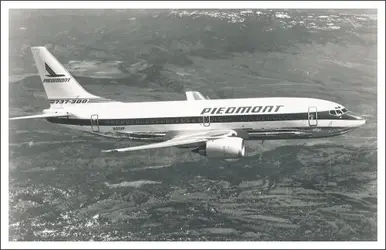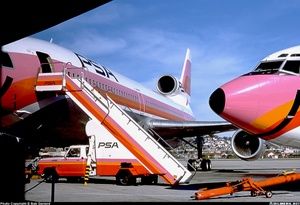More on Air Canada... seems to apply to US Airways. If only US Airways would discover the word "simplicity".
=========================================
BREAKING THE MOLD
The first network carrier to break the mold and transform into a low-fare, low-cost model is warning ailing legacy airlines to morph . . . or die.
The alert is not new. For several years, Air Canada CEO Robert A. Milton has been telling his legacy counterparts to shed the classic model. He said there are two kinds of airlines--those that restructure successfully and "the walking dead," those that cling to outdated models and do not embrace "the new reality," as Executive Vice President-Commercial Montie Brewer calls today's business environment.
The caveat became more urgent with the emergence of Air Canada on Oct. 1 from 1.5 years under creditor protection. During that time, it slashed costs, reengineered its fleet, renegotiated labor agreements and, in short, transformed itself into a global version of Southwest Airlines. Here, indeed, was the first legacy carrier that went through hard times, faced annihilation, entered creditor protection and reappeared with a good chance of survival as a low-cost carrier.
"I never wanted to file for creditor protection," Milton told Aviation Week & Space Technology the morning of Oct. 1, when the carrier received C$1.1 billion ($0.87 billion) in refinancing. "Most CEOs are programmed the same way, trying to protect the shareholder to the last possible minute," says Milton, who describes his business philosophy as "I'm willing to try anything that makes sense."
Milton provided the history of a legacy-turned-low-fare carrier. It started in 1999 when American Airlines tried to buy out Air Canada. "We fought that off and merged with Canadian Airlines. That was the first level of unplanned stress," said Milton. Then came the high-tech meltdown, followed by Sept. 11, 2001. "The U.S. airline industry got tremendous financial support. We received C$61 million. If we had been a U.S. airline, we would have received about $1 billion--and we would not have filed."
At the same time, low-cost carriers were proliferating, and the carrier had an increasing inability to reduce labor and aircraft ownership costs. Fuel prices were volatile and the lackluster economy led to a decline in premium business markets.
The carrier sought to get back to profitability in 2002, said Milton. However, the Iraq buildup came at year's end and "we were back under incredible pressure. Then came the death blow, SARS [the severe acute respiratory syndrome]."
Air Canada was hit hard by SARS, particularly at Toronto. In May 2003, the illness was blamed for a 26.4% decrease in revenue passenger miles (RPMs) and a capacity decrease of 21% compared with May 2002. SARS had a C$125-million negative impact on the carrier's revenues in April 2003 alone.
In 2002, Air Canada suffered a net loss of C$828 million and by year-end, had assets of C$7.412 billion and liabilities of C$9.7 billion. Operating losses on Apr. 2, 2003, were C$684 million.
Seeing that the old model was "broken," Milton decided: "Let's do it, there's no other choice." And on Apr. 3, 2003, the carrier filed for creditor protection under Canada's Companies' Creditors Arrangement Act--with C$3 billion of unencumbered assets. He said this set Air Canada apart from U.S. carriers, which don't have unencumbered assets.
"Looking at the carriers trying to avoid filing [for bankruptcy protection] with debt levels of $20 billion, I understand the fight they are trying to fight," says Milton. "But I have got to say the restructuring process is a very liberating one, enabling us to get things done in the last 18 months that I know never would have happened on a consensual basis."
Management met every day for about 18 months with "sheer determination," role-playing as customers, airline personnel and suppliers, all the while sculpting the business plan. Its foundation: to make Air Canada a viable long-term competitor in a changing marketplace. The effort aimed to eliminate complexity. "Simplicity was our mantra," says Brewer.
To fulfill its goals, the carrier aimed to reduce airline operating costs by C$2.1 billion and attain labor costs savings of C$1.1 billion annually. In addition, it had to raise an estimated C$1.35 billion in new equity and debt financing to competitive levels through renegotiated collective bargaining agreements and aircraft leases. It also had to redesign its network and reorganize its corporate structure.
Building a simplified, transparent low-fare structure, one that made it easy for the customer to book online, was a top priority. Customer trust in major carriers was dwindling, particularly in the area of ticket pricing. In May 2003, Air Canada introduced the new strategy in domestic markets. Last February, the model was expanded to most destinations in the continental U.S. served by the mainline and its regional arm, Jazz.
"Transparent pricing on the Internet is a revenue negative, not a revenue positive," notes Paul Brotto, executive vice president for planning and cost management. "But that's where [the market's] going to wind up. So you might as well deal with that up front and take the hit now. The pricing is going to force the old dogs to do new tricks."
"There was a dramatic change in inventory management," says Brewer, with a reduction in the number of fare types to five from 22. "We ran out of letters of the alphabet," referring to ticket codes.
Under the new structure, customers have control of the desired one-way ticket type, starting from the lowest fare and paying consecutively higher prices for premiums such as priority seating or return-date flexibility. Online customers will also see competitors' fares for comparison. "Online booking is easy to use. Now there's no more buyers' remorse," says Brewer.
The Internet is the focal point of the business strategy. In May, one month after filing for creditor protection, the airline had 10% domestic web penetration; by November it had grown to 24%, and by March 29%. In 2006, it's expected to reach 92% penetration domestically, 65% transborder with the U.S. and 40% internationally.
Delta Air Lines has been testing low fares slowly in Cincinnati, "but they have got to go further. We have become a testbed for legacy carriers," says Milton. However, he cites one difference between Canada and U.S. operations: Canada has a limited number of markets that account for the majority of passenger traffic: Vancouver, Edmonton, Calgary, Winnipeg, Ottawa, Toronto, Montreal and Halifax.
Another key component of the business plan--fleet restructuring--is aimed at increased utilization of aircraft, particularly new regional jets in domestic and transborder markets, to attain lower trip costs. By the end of 2007, Air Canada plans to operate 44 Embraer 190s and Jazz, 65 Bombardier CRJ-series aircraft. Less efficient aircraft, including Boeing 747-400s and 737-200s, will be eliminated. The airline is aiming for all-electronic transactions and high-frequency service to feed international flights. Air Canada plans to expand service to Asia, Latin America and Europe in conjunction with Star Alliance partners.
In the restructuring, one-third of the workforce was slashed and labor negotiations with five unions were arduous. "Labor was in denial and reluctant to depart from old ways," says Brotto. "The key was to convince our unions that productivity, not just wage cuts, was [critical]. They realized they had to do things, but how was the question. Once you got through the emotion, things were fine."
The carrier was able to devise a more competitive "B" wage scale for new hires comparable to low-cost carriers. In addition, the plan encouraged senior employees to exit early and called for wage cuts on the "A" scale and a change of work rules.
In June, Air Canada's five unions reached accords that would provide C$1.1 billion in required cost savings. In July, GE Capital Aircraft Services and International Lease Financing Corp. agreed to restructure aircraft leases.
When Milton first contemplated transforming Air Canada into a low-cost, low-fare carrier,"the unions screamed bloody murder, the government screamed bloody murder. We could not get union cooperation, so eventually, through frustration, I launched Tango in October 2001. It was modeled on JetBlue [Airways]. In fact, the code name of the project was JetRed," he said.
ALTHOUGH THE UNIONS could not be won over to low-cost ways, Tango was in every way a no-frills service, and there was no interlining with Air Canada. After the first year, Tango served 2 million passengers and web penetration was 90%. Milton says "costs came tumbling down, and there were no complaints from Tango customers, although complaints kept rolling in on the mainline."
For Milton, the most difficult part of restructuring was filing for creditor protection. The pullout of a C$650-million, 31% equity stake by investor Victor Li (Trinity Time Investments) in April was "very tough." Nevertheless, Air Canada raised C$1.1 billion equity funding.
Is the new business plan an exact match to that of budget carriers? "Not completely," says Brotto, noting that Air Canada still has about 20% interlining and some complexity in fare structure.
As for the future, Milton acknowledges "there's lots to do." The carrier plans to bring web fares to the international arena, probably by year-end. It will continue to fine-tune its business plan, as well as reinvest in product--for example, installing seatback video devices on its entire fleet.
"The next big acid test is to see if the Embraer 190s will do what we want them to do," says Milton.
Low-cost carriers at home, such as WestJet, and in the U.S. remain a competitive threat. They're not yet a factor in the international arena. Brotto predicts the budget airlines will concentrate on building transcontinental services in the next 5-8 years and gradually expand to international. "After all, 737s and Airbus narrowbodies can fly the Atlantic," emphasizes Brotto. "But that's not low-hanging fruit at the moment."
And Air Canada faces the same risks as other airlines: the economy, war and acts of terrorism, as well as rising fuel prices. It has not been able to hedge fuel.
Michael Lowry, an industry analyst who publishes AirWatch, a monthly study of major airline solvency, says the Air Canada venture is "very encouraging." His rating system shows that the airline has a very low risk of failure.
Air Canada executives are upbeat about the future, owing to record load factors for the six-month April-September period and the third-quarter earnings forecast. The airline is expected to have a cash balance of C$1.9 million at the end of the quarter and C$235 million in operating income before reorganization items. This compares with C$17 million in the same period of 2003. Milton believes this reflects the fact that the airline has made "tremendous progress, even in the face of a 41% increase in base fuel prices."
Milton says there will continue to be a push toward value pricing, and there's "no escaping" the consumer preference for nonstop, point-to-point service.
"As much as legacy carriers might have liked to perpetuate the old fare or hub structures, smaller hubs will disappear and there will be industry consolidation beyond what we are seeing," he says. "There will be some failures, and really only those carriers that radically restructure or start anew will survive."
However, U.S. carriers are not doing enough, Milton asserts. They are "trying to cut costs according to the world as they know it, and not the changing market. They must do more, and be configured to be truly competitive with low-cost carriers, or they will die."
AIR CANADA
Capacity Comparison First Nine Months of 2003 and 2004
2003 2004 Change
Mainline*
Revenue passenger miles (RPM) (Millions) 29,010 32,401 11.70%
Available seat miles (ASM) 38,931 41,578 6.80%
% Load Factor 74.5 77.9 +3.4 points
Canada (Domestic)
RPMs 9,278 9.976 5.40%
ASMs 12,863 12,661 -1.60%
% Load factor 72.1 77.2 +5.1 points
U.S. Transborder
RPMs 5,066 4,922 -2.80%
ASMs 7,609 7,077 -7.00%
% Load Factor 66.6 69.5 +2.9 points
Pacific
RPMs 3,501 6,193 76.90%
ASMs 4,564 7,551 65.40%
% Load Factor 76.7 82 +5.3 points
Atlantic
RPMs 9,083 8,720 -4.00%
ASMs 11,145 10,612 -4.80%
% Load Factor 81.5 82.2 +0.7 points
*Includes Zip and Jetz
Source: Air Canada filings





